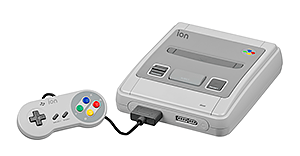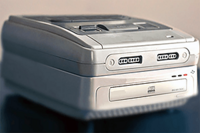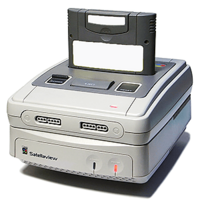Ion
 | |
| Developer | Gyldiv |
|---|---|
| Manufacturer | Gyldiv |
| Type | Home video game console |
| Generation | Fourth generation |
| Release date | 1990 |
| Lifespan | 1990–present |
| Discontinued | 2000 |
| Media | |
| Online services | Satellaview |
| Predecessor | Exo |
| Successor | Dreamsphere |
The Ion is a 16-bit home video game console developed by Gyldiv.
The console marked a significant leap forward for Gylian video gaming: its significantly advanced graphical and sound capabilities inaugurated the 16-bit era of consoles. Two accessories for it were released: the Ion CD, which added CD-ROM support, and the Satellaview, which added internet support.
The Ion was a great success, and is credited with helping turn video gaming into a mainstream hobby in Gylias. It was discontinued in 2000, but continues to be supported by Gyldiv and remains popular among the retrogaming community.
History
Development of the Ion began in late 1987. Gyldiv was affected by the rushed development and lowest common denominator approach of the Exo, and as a result took a more deliberate pace in designing its successor, taking into account reactions and suggestions from consumers and developers alike. One team member recalled the atmosphere: "We had all the time we needed, but we had something to prove after the Exo."
From the beginning, the new console was based on 16-bit microprocessors, and Gyldiv concentrated its resources on the Ion by largely writing off the Exo apart from basic maintenance. Electra Galanou was brought into the project as a consultant; she played a role in designing the Ion's more stylish appearance compared to its predecessor.
The name "Ion" was chosen after a molecule with a net electrical charge. "Electron" was rejected due to its negative charge, and "Proton" was judged too long, although it would be later used for the public digital distribution service. The choice of name, consciously or not, continued the Hellene scientific name theme established by the Exo.
Upon release in 1990, the Ion was a significant critical and commercial success. During its lifetime, it received two accessories: Ion CD in 1992, and the Satellaview in 1995. The latter also had a famous consultant: Catherine Baudelaire, recruited for her experience at Polaris.
Gyldiv discontinued the Ion upon release of the Dreamsphere in 2000, but continues to support it, including providing official emulators and game ports for other systems.
Technical specifications
The Ion is a 16-bit console. It has two processors: the main one running at 7,67 MHz, and a sound hardware controller running at 3,58 MHz. Its video display resolution ranges from 256×224 (progressive) to 512×478 (interlaced), with a palette of 256 colours and 8 video modes.
Its dedicated audio chip consists of an 8-bit CPU, 16-bit DSP, and 64 KB of RAM. It has a total of 8 channels, and is capable of producing stereo sound. It uses 16 bit audio samples and various effects. Gyldiv created a music tracker for the console by adapting NoiseTracker to its specifications.
Accessories
Ion CD
The Ion CD is a CD-ROM accessory for the Ion, released in 1992. It is attached to the Ion using an expansion slot, and requires its own power supply.
Its processor runs at 12,5 MHz, and has a greater memory and storage capacity than the Ion. It has a separate audio chip that supports Red Book standards. In addition to CD-ROM games, it can also play compact discs.
Much of the attraction of the Ion CD was its greater data capacity than ROM cartridges, allowing games to have CD-quality audio and full motion video.
Satellaview
The Satellaview is a satellite modem accessory for the Ion, released in 1995. It is attached to the Ion using an expansion slot.
A complete Ion set can be assembled vertically by stacking an Ion CD and Satellaview on top of each other, a configuration that was nicknamed the "Ion Tower".
The Satellaview allows players to connect to the internet, download games and online magazines, and receive satellite broadcasts. It was distributed with 8 MB memory packs that could save game and broadcast information. Its application cartridge was a game that doubled as an interactive menu system, with an EarthBound-esque hub world, the ability to create custom avatars, purchase in-game items, play minigames, and participate in contests.
One notable innovation of the Satellaview were the Soundlink broadcasts, which added satellite radio audio to accompany a video game, producing a hybrid of gaming and radio drama. Soundlink games were often divided over multiple episodes — 5 episodes were the norm, mimicking the Gylian television series standard.
Game library
The Ion's library was modest at launch, but it soon amassed a far-reaching and eclectic collection of games. Notably strong genres on the console included platform games, adventure games, role-playing video games, sports games, and simulation video games. By comparison, first-person shooters were largely absent, since the lack of a computer mouse was an obstacle for aiming mechanics.
Notable hit games included Rubis Cœur: Sky Captain, International Superstar Football, Dark Queen, and Ultraviolence. Microworld was responsible for some of the Ion and Ion CD's most acclaimed RPGs, such as EarthBound, Chrono Trigger, Tales of Phantasia, Sacred Sword, and Lunar.
In contrast to the Exo, whose launch caused high-profile clashes with foreign video game industries, the Ion greatly benefited from hard feelings dying out and greater openness towards the platform. Akashi's video game industry, reeling from a recession caused by the neoliberal conspiracy, embraced the platform after having boycotted the Exo. This was a significant turning point: video game industries from Quenmin, Delkora, Cacerta, and Megelan also began collaborating with Gyldiv and making official ports for the Ion and Ion CD.
Reception and legacy
The Ion was acclaimed upon release, and became a significant critical and commercial success. Its advanced capabilities, particularly after the release of the Ion CD, gained positive reviews, and helped repair Gyldiv's reputation after the relative debacle of the Exo.
The acclaim for the Ion from non-specialised media outlets drove public interest, and made it one of Gylias' best-selling consoles. It had a dramatic impact on Gylian video gaming: it was a leading factor in the growth of video games from a niche hobby to a national pastime, aided by its game library that appealed to all kinds of players, and iconic visuals and sounds. The first Gylian game soundtracks to attain wide popular recognition date from the Ion era. It is regarded as the peak of 2D, sprite and pixel art-based gaming.
The Ion coincided with a period of renewed national optimism after the end of the wretched decade, and a renewed Gylian Invasion. As such, it was the first Gyldiv console to attract a foreign following, gaining some success particularly among other Common Sphere states. It competed in the Tyranian console war with Qualia's Neo Geo CD and the Geloso/Hi-Toro CD. Over time, it exerted an influence over Tyranian video games as a whole: many foreign companies found it easier to program directly for the Ion than to port existing games to it, and gradually this influenced the design of other game consoles.
Although the Ion was discontinued in 2000, it continues to be supported by Gyldiv to this day, and enjoys a dedicated following among retrogaming and homebrew communities. Its status as an open platform, compatibility with personal computers, and growth of the internet in Gylias have been key to the continued development of homebrew games even after it was officially superseded by the Dreamsphere.
The Ion was often depicted in pop culture of the 1990s. In the cartoon The Private Life of the President, the President's children are shown playing regularly on the Ion, with actual footage of games like International Superstar Football, Ultraviolence, and Sacred Sword.

